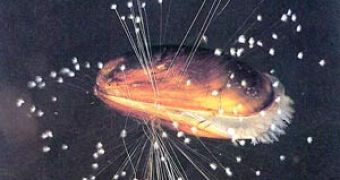Mussels have puzzled humans since ever with their ability to attach themselves to the rocks. They can resist the power of the waves or hungry predators and cannot be pulled out. When the mussel larva 'establishes' in a site, it puts out its tongue-shaped foot and through a channel along its foot slides a viscous protein cocktail that in a moment stiffens into 2 cm long elastic filaments.
After that, a mini "cushion" placed on the extremity of the filament spits a droplet of natural adhesive, the mussel raises its foot and the first anchorage is ready. These fibers form the byssus, securing the mussel to its residence rock. People investigate the byssus in the search of a type of glue that is not toxic, so flexible that it penetrates the smallest corners and adheres to any surface type, including that under water. Boats could be fixed on the water, without manycosts.
And a paint that does not oxidize for bodywork is the dream of the drivers. Surgeons could use it to join broken bones or closing up wounds and stomatologists to fill cracked teeth.
But the substance could not be achieved directly from mussels as a gram is achieved from about 10,000 mussels. A brainy new approach could be a step towards this universal adhesive coating.
A team led by Phillip Messersmith, a biomedical engineer at Northwestern University in Evanston, Illinois, has discovered that the two main ingredients in the mussel's sticky cocktail are also found in dopamine, a brain neurotransmitter.
That's why the team started with dopamine for achieving an adhesive coating approaching the mussels' natural stickiness. They poured a drop of pure dopamine to a beaker of water presenting the same acidity as seawater. The dopamine molecules formed large molecular chains called polymers. The polydopamine was extremely sticky. Any object soaked in the new solution got coated with a thin, adhesive film.
"It pretty much worked well on just about any material that we tried. It is really tremendously simple." said Messersmith. The dopamine-based glue could make materials stick to objects. Certain materials applied over a sticky object could impede an object from turning contaminated, a desirable trait for medical instruments.
Secondary exposure to a copper nitrate solution offers a metallic glow to objects, with applications in devices for flexible displays. Water contaminated with mercury or lead could be cleaned while passing it through a water tank with beads coated in the adhesive.
"Each of these applications involves pretty much the same first step but a different second step," said Messersmith. "Messersmith's team deserves credit for reducing the complex ingredients to two very simple features to make their sticky coating. It's nice that the mussel inspired it with its own highly evolved adhesive technology, but it isn't the same thing as mussel adhesion. If a mussel just squirted dopamine, the chemical would simply diffuse into the large volume of surrounding seawater. What works for man would not have worked for the mussel." commented Herbert Waite, marine biologist at the University of California, Santa Barbara, who investigated the way each ingredient in the mussels' protein cocktail works for making the mollusks so sticky.

 14 DAY TRIAL //
14 DAY TRIAL //